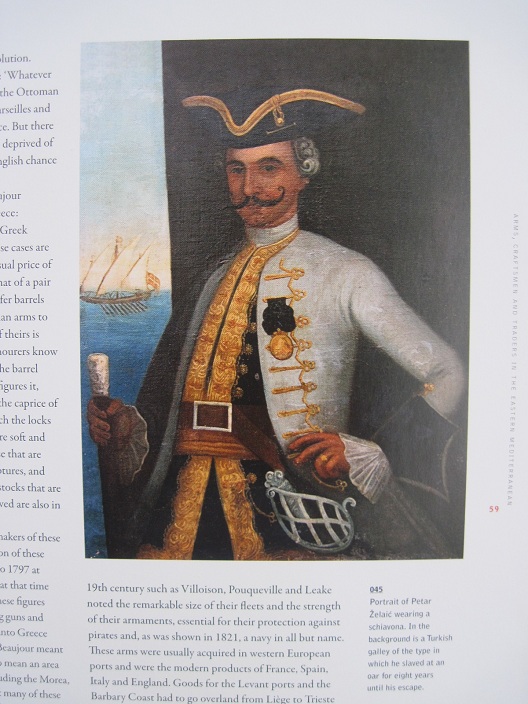Friends,
The schiavona is mentioned frequently here, but I don't think we've ever seen photos of anyone using this sword in period costume. This past weekend fellow forumite Tom Carr and I went to meet the local SCA group at their holiday social, and in the process took a few pictures -- him as border reiver, me as stradiot with my type I schiavona (the earlier form used ca. late 16th-17thc).
http://www.forensicfashion.com/1590StradiotCa...ulace.html
This same sword appears in Nathan's schiavona article, though there it looks much more polished than it does now.
http://www.myArmoury.com/view.html?features/pic_spot_schia51.jpg
[ Linked Image ][ Linked Image ]
Type 1 and Type 2/2a/2b schiavona forms were contemporaries. One type is not necessarily earlier than the other. It is often misrepresented that the Type 1 is earlier because it is of a visually simpler form. This is largely unsubstantiated. There are many extent Type 1 hilts that date later than Type 2 hilts. Further, I'm unaware of any fully-formed schiavone dating to the 16th century, or even before mid-17th century. Many sources misrepresent the dates of these swords. I'm not sure why.
I relied on North 1993, Venner 1986, Stone 1934, and Evangelista 1995 for the 16thc attribution, and on Sutt 1999 for type I being earlier . See http://www.forensicfashion.com/1590StradiotCavalry.html , s.v. "Sword."
I haven't looked into either matter independently. However, the Nujum al-'Ulum, a Deccan manuscript, does show a schiavona-like sword ca. 1570 -- well within the 16thc. Since this hilt form has no precedent anywhere in India or Asia, it must've come from Europe. Even if we don't admit this as a fully-developed schiavona, it has enough recognizable features to convince me that the form was already stabilizing by the late 16thc, and that attributions to that time are reasonable.
[ Linked Image ]
I haven't looked into either matter independently. However, the Nujum al-'Ulum, a Deccan manuscript, does show a schiavona-like sword ca. 1570 -- well within the 16thc. Since this hilt form has no precedent anywhere in India or Asia, it must've come from Europe. Even if we don't admit this as a fully-developed schiavona, it has enough recognizable features to convince me that the form was already stabilizing by the late 16thc, and that attributions to that time are reasonable.
[ Linked Image ]
Just to follow up, attached below is an 18th century image of a Balkan captain with a simple schiavona hilt, most similar to type I. From images like this I agree that simpler type I hilts coexisted with more complex ones in later times, but I'm unpersuaded that the opposite is true -- that complex hilts existed from the very beginning of the schiavona form.
With every hilt form we see historically, complex forms never arise ex nihilo; they develop from simpler forms. Swepthilt rapiers, baskethilt claymores, etc.etc. all have precedents in simpler hilt arrangements. It's hard to believe that the schiavona would defy this totally consistent pattern in the evidence.
 Attachment: 156.6 KB
Attachment: 156.6 KB

With every hilt form we see historically, complex forms never arise ex nihilo; they develop from simpler forms. Swepthilt rapiers, baskethilt claymores, etc.etc. all have precedents in simpler hilt arrangements. It's hard to believe that the schiavona would defy this totally consistent pattern in the evidence.

Page 1 of 1
You cannot post new topics in this forumYou cannot reply to topics in this forum
You cannot edit your posts in this forum
You cannot delete your posts in this forum
You cannot vote in polls in this forum
You cannot attach files in this forum
You can download files in this forum
All contents © Copyright 2003-2006 myArmoury.com — All rights reserved
Discussion forums powered by phpBB © The phpBB Group
Switch to the Full-featured Version of the forum
Discussion forums powered by phpBB © The phpBB Group
Switch to the Full-featured Version of the forum